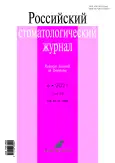Quality of life of patients with complete loss of teeth and psychometric properties of the OHIP-20 DG questionnaire. Part 4. Evaluation of the parameters using a nonlinear principal components analysis by the CatPCA algorithm
- Authors: Muslov S.A.1, Nokhrin D.Y.2, Arutyunov S.D.1, Chizhmakov E.A.1, Pivovarov A.A.1, Platonova M.S.1
-
Affiliations:
- A.I. Evdokimov Moscow State Medical and Dental University
- Chelyabinsk State University
- Issue: Vol 25, No 6 (2021)
- Pages: 495-503
- Section: Experimental and Theoretical Investigation
- URL: https://journals.rcsi.science/1728-2802/article/view/107459
- DOI: https://doi.org/10.17816/1728-2802-2021-25-6-495-503
- ID: 107459
Cite item
Abstract
BACKGROUND: The study researched the structure of the OHIP-20 DG questionnaire, which was compiled from the questions of the validated international special questionnaire OHIP-49, to assess the patients’ quality of life depending on their mouths’ organs and tissue with the help of сategorical principal component analysis.
PURPOSE OF THE STUDY: Reduce the original set of variables to an uncorrelated variables that carry the bulk of the information contained in the original set.
MATERIAL AND METHODS: To determine the connections between the scales of the quality of life (QoL) questionnaire OHIP-20 DG and to assess the factor validity of the latter, data reduction with generalization procedure was conducted by the method of nonlinear principal component using the CatPCA algorithm.
RESULTS: All scores from 0 to 4 were smoothed by a second-degree polynomial spline with three internal knots and ranking as a discretization method. To determine the number of necessary and sufficient components, Cattell’s scree plot and broken stick criteria were used. Calculations were performed using the IBM SPSS Statistics package (version 20), graphical constructions in the KyPlot (version 6.0), and PAST (version 4.06) packages.
CONCLUSION: The factor structure of the questionnaire was explored using CatPCA algorithm of nonlinear principal component analysis. The analysis confirmed the factor validity of the OHIP-20 DG questionnaire, but found two weak structural elements that are not related to the QoL, but most likely have a connection with the psychosocial aspects of patients’ health. Comparison of the questionnaires’ initial scores with their quantification values revealed the nonlinearity of patients’ perception of most of the questionnaire items. Which allows for a broader interpretation of the patterns of patients’ perception of QoL and further improvement of the questionnaire.
Full Text
##article.viewOnOriginalSite##About the authors
Sergey A. Muslov
A.I. Evdokimov Moscow State Medical and Dental University
Author for correspondence.
Email: muslov@mail.ru
ORCID iD: 0000-0002-9752-6804
Dr. Sci. (Biological, Physico-Mathematical), professor
Russian Federation, 20, buil. 1, Delegatskaya str., Moscow, 127018Denis Yu. Nokhrin
Chelyabinsk State University
Email: nokhrindenis@gmail.com
ORCID iD: 0000-0002-4920-2338
MD, Cand. Sci. (Biol.)
Russian Federation, ChelyabinskSergey D. Arutyunov
A.I. Evdokimov Moscow State Medical and Dental University
Email: sd.arutyunov@mail.ru
ORCID iD: 0000-0001-6512-8724
MD, Dr. Sci. (Med.), professor
Russian Federation, 20, buil. 1, Delegatskaya str., Moscow, 127018Evgeny A. Chizhmakov
A.I. Evdokimov Moscow State Medical and Dental University
Email: evgeniychigmakov@yandex.ru
ORCID iD: 0000-0003-1313-3307
Russian Federation, 20, buil. 1, Delegatskaya str., Moscow, 127018
Anton A. Pivovarov
A.I. Evdokimov Moscow State Medical and Dental University
Email: pivovarovanton@mail.ru
ORCID iD: 0000-0001-9778-0258
MD, Cand. Sci. (Med.), associate professor
Russian Federation, 20, buil. 1, Delegatskaya str., Moscow, 127018Maria S. Platonova
A.I. Evdokimov Moscow State Medical and Dental University
Email: platonovamaria@yandex.ru
ORCID iD: 0000-0002-0137-857X
Russian Federation, 20, buil. 1, Delegatskaya str., Moscow, 127018
References
- Gazhva SI, Gazhva YV, Guluev RS. The quality of life in paitents with diseases of oral cavity (review of literature). Modern Problems of Science and Education. 2012;(4):2. (In Russ).
- Patent RUS № 2021613358/ 19.02.2021. Arutyunov SD, Muslov SA, Grachev DI, et al. Programma dlya EVM “OHIP-20-DG”. Available from: https://elibrary.ru/item.asp?id=45819191
- IBM [Internet]. Categorical principal components analysis (2021) [cited 15 Mar 2022]. Available from: https://www.ibm.com/docs/ru/spss-statistics/SaaS?topic=categories-categorical-principal-components-analysis-catpca
- Fomina EE. Factor analysis and categorial principal component analysis: comparative analysis and practical application for processing of questionnaire survey results. Humanities Bulletin of BMSTU. 2017(10):3. (In Russ). doi: 10.18698/2306-8477-2017-10-473
- Van der Kooij AJ, Meulman JJ. Categorical Principal Components Analysis. In: Meulman JJ, Heiser WJ, editors. SPPS Categories 10.0. Chicago: SPSS Inc.; 1999. P. 1–9, 103–126, 221–237.
- Gifi А. Nonlinear Multivariate Analysis. New York: John Wiley & Sons; 1990.
- Michailidis G, de Leeuw J. The Gifi System of Descriptive Multivariate Analysis. Statistical Science. 1998;13(4):307–336.
- Manisera M, van der Kooij AJ, Dusseldorp E. Identifying the Component Structure of Satisfaction Scales by Nonlinear Principal Components Analysis. Quality Technology & Quantitative Management. 2016;7(2):97–115. doi: 10.1080/16843703.2010.11673222
- Nokhrin DY. Laboratornyi praktikum po biostatistike. Chelyabinsk: ChelGU; 2018. (In Russ).
- Isakin MA, Teplykh GV. Research of higher engineering education quality on the base of students interviewing data by nonlinear principal components analysis (NLPCA). Applied Econometrics. 2011;(1):70–96. (In Russ).
- Zangieva I, Rotmistrov A. Factor analysis of ordinal variables: a comparative study. Monitoring of Public Opinion: Economic and Social Changes. 2018(3):29–46. (In Russ). doi: 10.14515/monitoring.2018.3.02
- Tolstova YN. Izmerenie v sotsiologii: Kurs lektsii. Moscow: Infra-M; 1998. (In Russ).
Supplementary files











